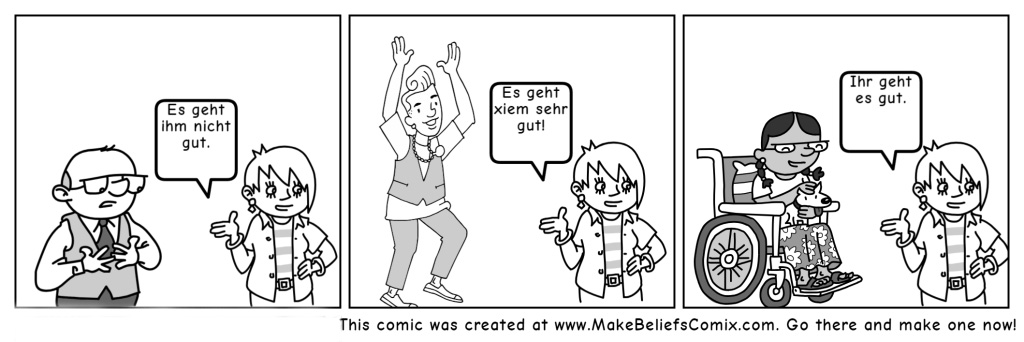3.3 Wie geht es dir? Wie geht es ihr?

Hallo alle zusammen!
Zum Aufwärmen machen wir unseren Tagesminiplausch und eine Wiederholung.
Wiederholung
Let’s review what we learned about characteristics and how to make comparisons.
Jetzt bist du dran!
Play a memory game with yourself. In your written journal, write down as many characteristics as you can in one minute. Check your spelling using the previous lesson or visit an online dictionary like Leo.
Lektionsüberblick
Let’s recall that asking “Wie geht’s” in German is never used as a greeting. It is a earnest question expecting an honest answer. This lesson will expand on appropriate responses regarding your daily state of mind (Geisteszustände). In the end, you will be able to 1) respond to “Wie geht’s?” depending on your state of mind and 2) say how someone else is doing.
Was weißt du schon?
Let’s see what you already know about the question, Wie geht’s? before moving on.
| Noch nicht start klar?
Du kannst immer auf die gleiche 1010-Lektion zurückgreifen! |
Not confident about starting this lesson?
You can always review the same Lektion from 1010. |
1) Wie geht’s?
How are you doing today? Look below and say aloud the answer that fits best (two word order options are given for each one). It goes like this…
| Es geht mir sehr gut! | Es geht mir gut. | Es geht mir nicht schlecht. | Es geht mir nicht so gut. | Es geht mir schlecht. | Es geht mir sehr schlecht. |
| Mir geht es sehr gut! | Mir geht es gut. | Mir geht es nicht schlecht. | Mir geht es nicht so gut. | Mir geht es schlecht. | Mir geht es sehr schlecht. |
😀 |
🙂 |
😐 |
😞 |
😣 |
😩 |
Jetzt bist du dran!
2) How others are doing
Read and listen to the comic below.
 |
||
Jetzt bist du dran!
Österreich im Blickpunkt

Am 20.11.1989 gab Nirvana ihr erstes Konzert in Österreich am Kulturzentrum Kapu in Linz. 23 Jahre nach Kurt Cobains Tod (1994) malte der australischer Künstler Lushsux das rechtsstehene Meme als Wandbild an der Außenwand des Kapu: Abgebildet ist der US-amerikanische Schauspieler Davide Spade mit einem Zitat von Neil Young (“It’s better to burn out than fade away”), der hier “Cobain” zugeschrieben wird.
On November 20, 1989, Nirvana gave their first concert in Austria at the Culture Center Kapu in Linz. 23 years after Kurt Cobain’s death (1994), the Australian artist Lushsux painted the meme as a mural to the right on the wall of the Kapu: It is an image of American actor David Spade with a quote from Neil Young (“It’s better to burn out than fade away”) that is credited to “Cobain” in the mural.
Zum Schluß

*As you conclude this lesson, don’t forget to check Canvas!*

Media Attributions
- 1020-at-banner-large-1
- 3.4 comic ihr geht es gut
- Private:

